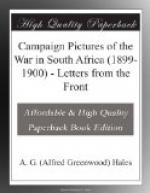Rundle gave an order to Driscoll, Captain of the Scouts, who had done such good service to the Eighth Division. What passed between the general and the Irish captain no man knows, probably no man will ever know. But when Driscoll rode up at the mad gallop so characteristic of the man there was that in his hard, ugly, wind-tanned face which spoke of stern deeds to be done. He did not ride alone, this Irish-Indian Volunteer captain—Rundle’s own aide, Lord Kensington, of the 15th Hussars, was on his right hand, and on his left Lieutenant Roger Tempest, of the Scots Guards, for a squad of the Scots Guards who had been learning scouting under Driscoll were to accompany Driscoll’s Scouts. That little group was characteristic of the future of the British Empire. Two aristocrats riding shoulder to shoulder with a wild dare-devil, whose rifle had cracked over half the earth. England, Ireland, and Scotland rode alone in front of the adventurous band that day. It was a reckless ride; the captain, on his grey stallion, half a length in front. They darted through gullies, drew rein and unslung rifles up hill, now standing in the stirrups to ease their cattle, now sitting tight in the saddle to drive them over the open veldt, taking every chance that a dare-devil crew could take, pausing for nothing, staying for nothing. Right into the town of Fouriesburg they galloped, down from their saddles they leaped, up went the rifles; the foe poured in a few shots, and, appalled by the devilish audacity of the deed, fled before a handful. It was a proud moment then, when, in the last stronghold of the foe in all the Free State, Kensington, the aide of the General of the Eighth Division, with a little band of officers grouped around him, with the Scouts and Scots Guards lying behind cover, rifle in hand, pulled down the Orange Free State flag in the very teeth of the foe. Only a little band of officers—Kensington, Driscoll, Davies, and Tempest. May their names be remembered when the wine cups flow!




